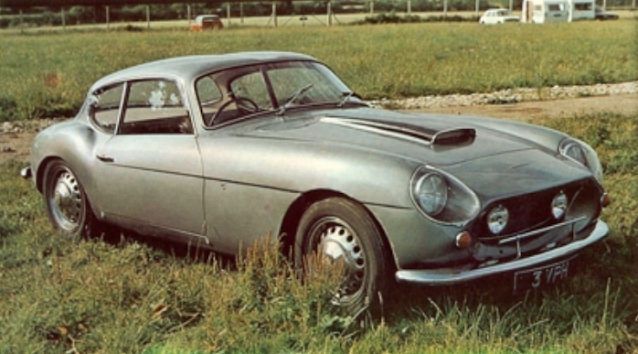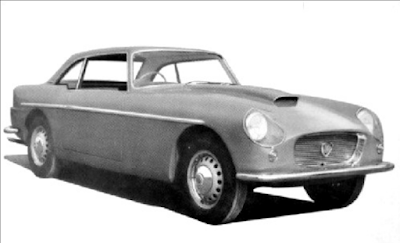If you'd encountered the light green car above, or the red one below, at a car show, you'd have likely identified them as Zagato* designs from the trademark "double bubble" roofs and the tight curves. Also, there are the bubble headlight covers, which appeared on Zagato's Alfa Romeos and Lancias of the Sixties. You might be surprised to find that what we see here are shortened (108" wheelbase) and lightened versions of England's expensive and eccentric Bristol 406...
But it's unlikely that you'd encounter one of these Zagato Bristol 406S models anyway, because no more than two 406S cars were built, starting in 1959. And you'll note we refer to them as Zagato Bristols, rather than Bristol Zagatos, because it was Anthony Crook, proprietor of Bristol's Kensington showroom, and not Bristol Aeroplane's car-making operation, that approached the Italian coachbuilder. The idea was to spark some new buyer interest in Bristol's upper crust cars, which were based on a BMW chassis and engine design dating back to 1936. By the time the Type 406 appeared in 1958, it was clear that the old long-stroke, cross-pushrod engine, now bored and stroked from 1971 cc to 2216, had neared the end of its design life, and had long become uncompetitive in Bristol's stratospheric price class, which included Aston Martin. So Tony Crook asked Zagato to design a more aerodynamic, weight-saving body. The final decision to order an initial run of 10 cars was based not on the short-chassis 406S pictured at the top, but on the standard 114" wheelbase 406. Unlike the previous, ash-framed Bristol 404 and 405 series, these Zagato 406s featured light, tubular steel superstructures on the ladder chassis to which alloy body panels were attached. Like the "standard" 406 sedan, the cars had a new, Watts-linkage rear suspension to replace the old BMW design, and also 4-wheel disc brakes as standard.
This idea of refining an existing design, rather than radical innovation (a la Citroen or Lancia) fits firmly into Bristol's approach. The company had moved into the upper crust automobile business after World War II by offering a warmed-over BMW 326 chassis with 328 engine to a car-starved British public, having obtained drawings through war reparations. But restyles by Superleggera Touring (Types 401-403), Dudley Hobbs (404 & 405*) and even Bertone (the American market Arnolt Bristol*) had kept the cars looking fresh. The 1960 press photo of the 4-passenger Zagato 406 on the long wheelbase manages to look pretty fresh...
...though squaring of the roof on "production" version shown below didn't help the proportions. And "production" needs to be understood within the confines of the six cars actually sold, some at steep discounts. Other Zagato bodies from the original order were used to re-body older Bristol chassis for some of Tony Crook's customers. What went wrong with Zagato's repackaging of the Bristol 406? It was a case of the competition offering better-performing cars at lower prices. The Aston Martin DB4 offered 240 hp to the new Bristol's 130, and at a lower price. And by late 1961, you could buy two E-type Jaguars for the original, non-discounted price of a Zagato Bristol...
Tony Crook didn't give up on Zagato, though. After taking a 50% stake in Bristol's automotive arm, he succeeded in getting Bristol to standardize a 5.1 liter Chrysler V8, making the 406 into the 407. With the old 6 cylinder out of the picture, he commissioned another Zagato body for a special 407 GTZ. The car was more graceful than any of the earlier efforts, and the return to the longer wheelbase could have allowed mounting the engine back farther in the chassis. But the car went from concept to completion in only 10 weeks to be ready for the October '61 Earls Court show, and test drives revealed the front-heavy character...

So ZUZ 407 remained the only Zagato-bodied V8 Bristol...well, at least for over a dozen years. Fashions changed over the years, but Tony Crook seemed fixated on the idea of a special, Zagato-designed Bristol, and eventually he would get one into what looked like series production, by Bristol standards, anyway...
After Tony took full control of Bristol's car-making operation in 1973, he would approach Zagato one more time about repackaging the aging chassis design, still based on the BMW box-section ladder frame. The 412, of which about 80 were made, was the last of the 4 Series begun with the 400 in 1947, sharing that car's 114" wheelbase and appearing in 1975. It followed the removable roof panel / solid roll bar / rear soft top format of Zagato's Lancia Beta Spider of the same year, but at a larger scale. Keeping a feature of the 405, the spare wheel hides behind the left panel ahead of the door, with the battery on the right. This made access easy, but gave a long hood to what was, after all, a car with compact V8 power. Despite Zagato's alloy body panels, dry weight was over 3,800 lb. and curb weight over 4,400.
After 1978, Bristol sourced body panels locally for a 2nd series 412 with a Chrysler 360 replacing the heavier 383. To provide added power, a turbocharged Beaufighter version (named after Bristol's WW2 plane; Crook had been a pilot in the RAF then) was offered from 1982 to '93, but no more than 20 were built. There was also a turbocharged Beaufort full convertible; as with all Bristols built after Tony Crook's takeover, production numbers are vague when available at all. Bristol production ended in 2011, a victim of a market that was no longer interested in repackaged versions of obsolete cars. If car enthusiasts were interested in reliving the past at all, it was in cars like the Morgan, that flaunted their obsolescence on the outside.
*Footnote:
This is Part 3 of a series of posts on cars bodied by Zagato. Other posts include "Body by Zagato Part 1: Ferrari and Maserati in the Fifties" (March 31, 2020) and "Body by Zagato Part 2: Five Decades of Alfa Romeos" (May 6, 2020). We had a look at Bristol history, including the Le Mans racers and Arnolt Bristols, in "Forgotten Classics: Muddling Through with Bristol" (September 23, 2016).
Photo Credits:
Top: uniquecarsandparts.com.au
2nd: flickr.com
3rd: Carrozzeria Zagato
4th: Classic Car Catalogue
5th & 6th: Wikimedia
7th: the author
8th & 9th: Wikimedia
Bottom: youtube.com









No comments:
Post a Comment